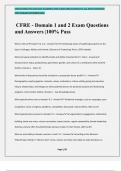EMILLYCHARLOTTE 2024/2025 ACADEMIC YAER ©2024 EMILLYCHARLOTTE. ALL RIGHTS RESERVED
FIRST PUBLISH SEPTEMBER 2024
CFRE - Domain 1 and 2 Exam Questions
and Answers |100% Pass
What is the LAI Principle? II.2, II.3, - Answer✔✔-The fundraising axiom of qualifying prospects on the
basis of Linkages, Ability, and Interest. (Glossary of Fundraising Terms, CFRE website)
What are typical indicators to identify trends and define characteristics? I, Task 3 - Answer✔✔-
Socioeconomic status, giving history, generation, gender, and culture of a constituency (Test Content
Outline: Domain 1 - Task 1.3)
What kinds of data points should be included in a prospective donor profile? I.1 - Answer✔✔-
Demographics, psycho-graphics, interests, values, motivations, culture, ability, giving and volunteer
history, relationships, and linkages to select potential donors for particular projects and fundraising
programs. (Test Content Outline: Domain 1 - Key Knowledge Areas)
What typically drives men to donate? II.2 - Answer✔✔-Traditional strategies, such as campaigns, peer
recognition, sense of urgency, deadlines, competitive, fast-paced, intense efforts. (AEF, p117)
What typically drives women to donate? II.2 - Answer✔✔-An organization's engagement, relationship
building, thank you notes, mission connection, impact stories, regular stewardship, female leadership,
diversity, and are often the philanthropic decision makers in their homes. (AEF, p119)
Who are more likely to donate: women or men? II.2 - Answer✔✔-According to the Women's
Philanthropy Institute's "Women Give" series, women are often more likely to make donations as
Page 1/16
,EMILLYCHARLOTTE 2024/2025 ACADEMIC YAER ©2024 EMILLYCHARLOTTE. ALL RIGHTS RESERVED
FIRST PUBLISH SEPTEMBER 2024
similarly-situated men. (AEF, p115) In 2 studies of high net worth households, 9 out of 10 women are
either the sole decision maker or at least an equal partner in charitable decision making. (AEF, p116)
What are Cohort and Lifecycle effects in relation to generational giving? II.2 - Answer✔✔-A cohort effect
is characteristic of people in the group *throughout* their lives. An example would be the lifelong
impact of economic scarcity from the Great Depression on a generation's attitudes towards money and
philanthropy. A lifecycle effect changes as an individual grows older. An example might be a young
person who becomes more generous in their 40s because she has more disposal income than she did in
her 20s. (AEF, p171)
What are the top 5 charitable causes that individuals are likely to support, across all generations? II.2 -
Answer✔✔-Local social service, place of worship, health charities, children's charities, and education.
The first four causes remain prominent across different generations, but there is variance across the fifth
selected cause, depending on the generation. (AEF, p173).
What are the elements of an effective case for support? II.1, 11.3, II.4 - Answer✔✔-Mission Statement,
Goals, Objectives, Programs & Services, Finances, Governance, Staffing, Service Delivery, Planning &
Evaluation, History (AEF, p40-41)
How do Goals differ from Objectives? II.1, 11.3, II.4 - Answer✔✔-Goals answer the bigger question of
"what does an organization do?" They are typically not easily measurable but articulate the bigger need
that the organization is working towards solving. Objectives differ from goals in degree of specificity.
They are more precise and explain how an organization expects to reach its goals. (AEF, p42-43)
What is the difference between an Internal Case and an External Case? II.1, 11.3, II.4 - Answer✔✔-
Internal Cases are the operational resource files that an organization can draw upon to develop the
Page 2/16
, EMILLYCHARLOTTE 2024/2025 ACADEMIC YAER ©2024 EMILLYCHARLOTTE. ALL RIGHTS RESERVED
FIRST PUBLISH SEPTEMBER 2024
External Case. External Cases are communicating the information in those files to prospective donors.
Think brochures, websites, proposals, direct mail letters, newsletters, and even face-to-face solicitation.
The External Case statement is, according to Rosso (1991), "the case at work." (AEF p.45)
What are the steps of the Fundraising Cycle? II.3 - Answer✔✔-* Planning Checkpoint: Examine the Case
> Analyze Market Requirements > Prepare the Needs Statement > Define Objectives
* Action Checkpoint: Involve Volunteers
* Planning/Action Checkpoint: Validate Needs Statement
* Planning Checkpoint: Evaluate Gift Markets > Select Fundraising Vehicle > Identify Potential Giving
Sources > Prepare Fundraising Plan > Prepare Communications Plan
* Action Checkpoint: Activate Volunteer Corps > Solicit the Gift
* Strategic Checkpoint: Demonstrate Stewardship and Renew the Gift
Repeat.
- AEF, p 29
What are S.M.A.R.T. goals? II.3 - Answer✔✔-* S: Specific
* M: Measurable
* A: Attainable/Achievable
* R: Results-Oriented/Realistic
* T: Time-determined/Timely/Time-bound
AEF, p 30
Page 3/16




